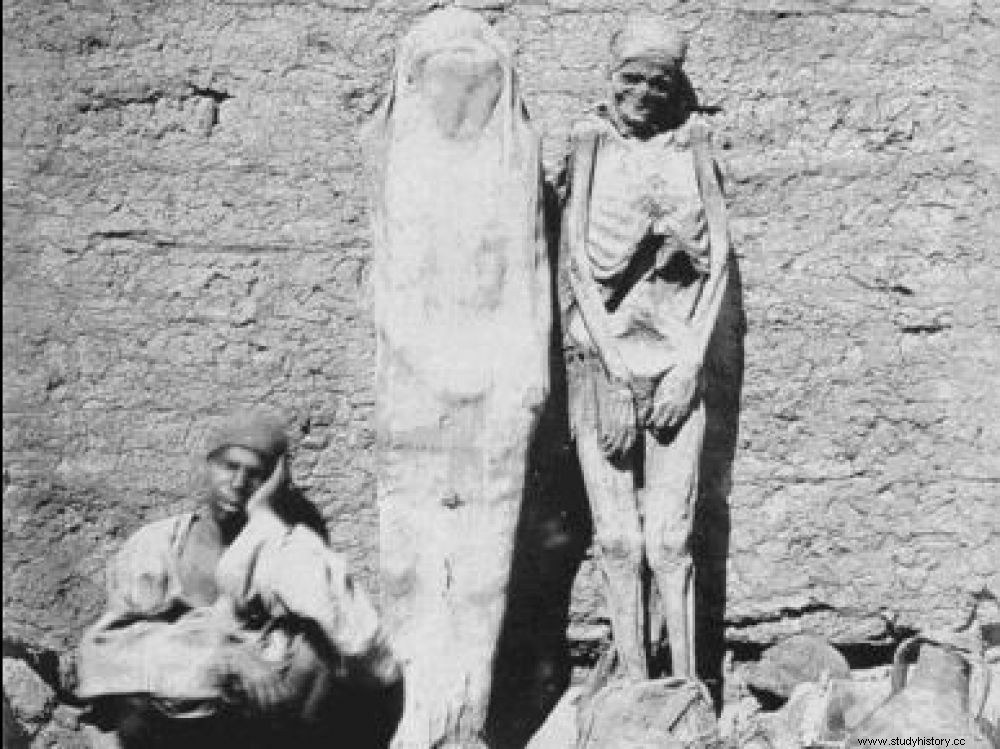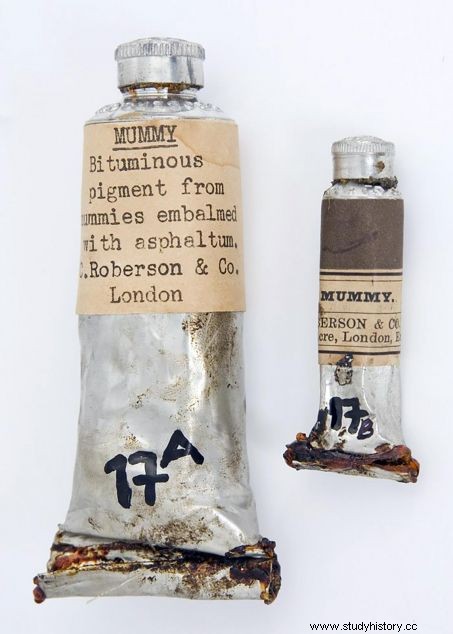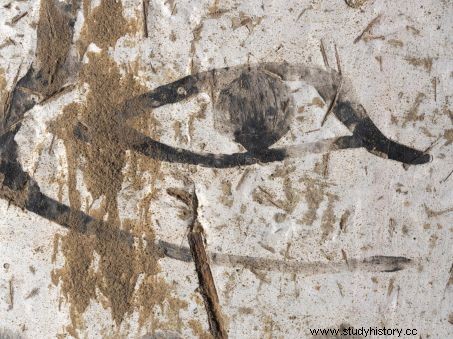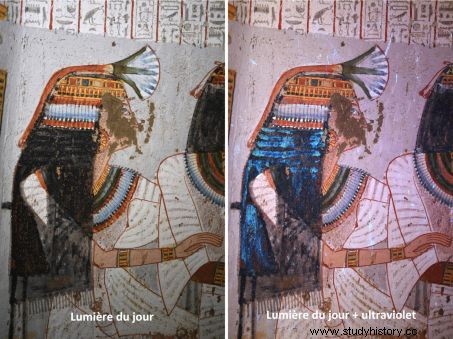The presence of mummies in the tomb of Amenouahsou recalls certain morbid uses that were made of them. Even mummy brown pigment was fashionable at one time in our history. The ancient Egyptians did not view embalmed bodies in this way and preferred carbon black for their murals. 11th episode of the Notebooks of Egypt.

Félix Bonfils, "seller of mummies", circa 1875.
It was not until the end of the 16th century that the doctor Ambroise Paré tried to put a stop to the morbid passion that led certain Western doctors to prescribe mummy powder as medicine. Learning about the ancient processes of mummification, he read ancient authors such as Herodotus and Strabo. But he mainly inquired with Guy de La Fontaine, doctor to the King of Navarre, who had just returned from Egypt. According to the latter, the mummies found in Europe are often prepared in a hurry in dubious pharmacies where the venerable embalmed corpses are often replaced by those of slaves who died of plague, pox or leprosy. . The Egyptian merchants themselves are surprised that the Christians, generally so delicate, can resolve to consume corpses. But business is business!
Other Parisian suppliers are even less careful, picking up the bodies of prisoners sentenced to death from the gallows at nightfall. Paracelsus himself does not reject the use of fresher bodies:for him, "if the doctors knew the power of this substance, no corpse would remain on the gallows for more than three days..." Paré published a treatise in 1586 in which he concluded that mumia "can do much more harm than help. To this cause, I protest never to order it, nor allow anyone to take it, if I is possible" . But the good sense of Paré who criticized this "good meat" , would hardly impress his colleagues, however, and mumia would continue to be part of the most common pharmacopoeia well into the 18th century of the Enlightenment.
From the medicinal mummy to the palette of painters
The death knell of the good times of the medicinal mummy has sounded, however, but the reconstituted stocks will allow it to integrate the painter's palette. As early as 1712, a Parisian colorist whose shop was called "À la Mummy" offered his customers a mixture made of mummy flesh, white resin and myrrh. The "mummy brown" was born, also known as the "caput mortuum" or death's head. The composition of the product seems variable and the percentage of real mummy rather limited:an English colorist confided in 1915 that a single mummified body could meet the demand of his customers for twenty years. Brown pigment offering good transparency, it could be used both with oil and in the form of watercolor. Around 1850, it is a fashionable pigment that can be found on the palette of Delacroix but also of the English Pre-Raphaelites Edward Burne-Jones and Alma-Tadema. The French artist Martin Drölling says he uses a revolutionary pigment obtained from the mummified remains of the bodies of the kings of France torn from the tombs of the Abbey of Saint-Denis.
Some artists find undeniable technical qualities in it:"It flows from the brush with marvelous freedom and homogeneity" . Mixed with oil and bitumen, it prevents cracking. But in most cases, the comments are increasingly negative. It is criticized for the inconstancy of its composition and the uncertainty of the result it entails. What was of interest to it not long ago is then reproached to it:mummy brown does not dry well and it contains ammonia and fats...
But it is a more ethical awareness that finally drives the nail into the coffin of the "mummy brown":Edward Burne-Jones suddenly realizing that the pigment he was using came from the corpses of dead pharaohs, hastened to fetched the tube in his possession and gave him a dignified burial in his own garden. Nevertheless, "mummy brown" was still on sale in London until the 1960s. And it is actually still possible to buy "mummy brown" on the internet. But the desiccated bodies present in the tomb of Amenouahsou can now rest in peace:it is nothing more than an industrial mixture of kaolin, quartz, goethite and hematite.

“Mummy Brown” tubes produced by C. Robertson and Co, London © Yale Art Museum.
The black pigment used by the ancient Egyptians is carbon-based
Analyzes that were carried out in the 1920s by the chemist Alfred Lucas, head of the laboratory of the Egyptian Museum in Cairo, showed that the carbon black pigment of the Egyptians could be obtained either by burning plants or wood, or by recovering soot. The first of the varieties still retains the plant structures and is identifiable using a video-microscope. The second contains grains so finely divided that it appears in the form of a compact and most often shiny mass:observed under an electron microscope, the soot is composed of grains with a size of a few hundred nanometers at most.
The observations made on the paintings of the tombs of the Valley of the Nobles unanimously demonstrate the use of soot. The black ink used by the scribes to write on the papyri was also prepared with soot, ensuring its homogeneous suspension in water by adding gum arabic extracted from acacia.

Maa sign, meaning "to see", painted with black carbon-based paint. © MAFTO-LAMS CNRS
The shiny appearance of this black paint was perhaps not always sufficient in the eyes of the artists. The observation with an ultraviolet light of the representations of wigs in the tomb of Amenouahsou reveals patterns which testify to the addition of another material on the black pigment, in the form of horizontal bands which must have contributed to give relief to the shape.

Tomb of Amenouahsou:painting observed in daylight and with the addition of ultraviolet. © MAFTO-LAMS/CNRS
What was it ? Non-invasive analyzes do not yet solve this problem. Chromatographic and mass spectrometric methods should be employed. Such an instrument is now part of the set of Martian soil characterization techniques installed on the Curiosity rover. . All that remains is to adapt it to be able to integrate it into our mobile laboratory and apply it to the in-situ study of Egyptian tomb paintings!
Notebooks of Egypt, 1st episode:how did the painters of ancient Egypt work?
Notebooks from Egypt, 2nd episode:Discovering the funeral chapel of Nakhtamon.
Notebooks from Egypt, 3rd episode:The pigments of Egyptian painting.
Notebooks from Egypt, 4th episode:The modern documentation of painted walls.
Notebooks from Egypt, 5th episode:Rediscovering the monuments of eternity of Ramses II.
Notebooks from Egypt, 6th episode:Revealing pigments with light:the visible and the invisible.
Notebooks from Egypt, 7th episode:Experiencing research through images.
Notebooks of Egypt, 8th episode:Beginning of the study of the paintings of the tomb of Nebamon and Ipouky.
Notebooks from Egypt, 9th episode:A tomb shared by two artists under Amenhotep III.
Notebooks from Egypt, 10th episode:What the tomb of Amenouahsou, an artist from ancient Egypt, reveals.
Notebooks from Egypt, 11th episode:Strange uses that have been made of Egyptian mummies.
Notebooks from Egypt, 12th episode:"Why don't all the artists come here?"
Notebooks of Egypt, 13th episode:Why did the Egyptians draw the characters in profile?
Notebooks from Egypt, 14th episode:Observing craft practices in Egyptian tombs.
Notebooks from Egypt, 15th episode:About Egyptian perfumes.
Notebooks from Egypt, 16th episode:The colors of the Egyptian palette.
Notebooks of Egypt, 17th episode:The Egyptian language does not know a word to designate "art".
Notebooks of Egypt, 18th episode:The day of a scientific mission in Egypt.
